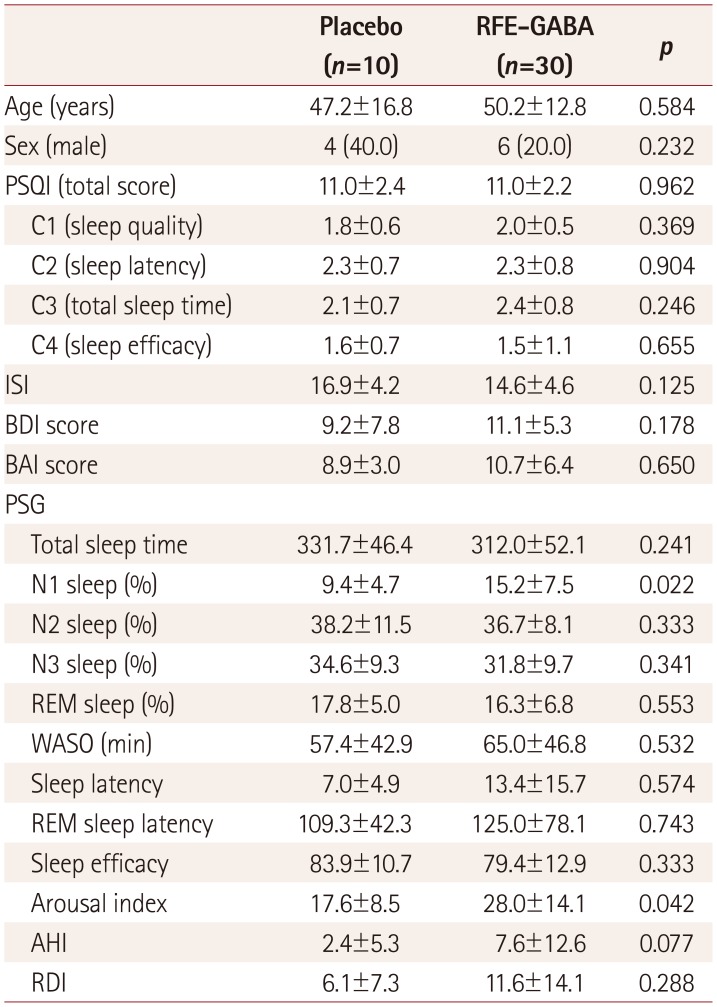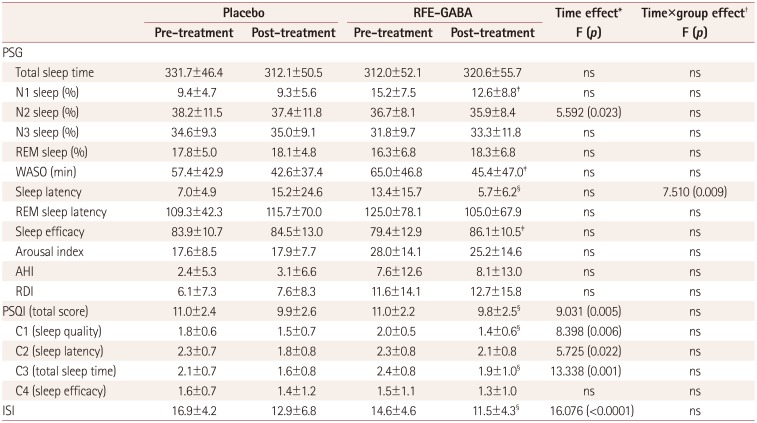1. Riemann D, Nissen C, Palagini L, Otte A, Perlis ML, Spiegelhalder K. The neurobiology, investigation, and treatment of chronic insomnia. Lancet Neurol. 2015; 14:547–558. PMID:
25895933.

2. Winkelman JW. Clinical practice. insomnia disorder. N Engl J Med. 2015; 373:1437–1444. PMID:
26444730.
3. Gottesmann C. GABA mechanisms and sleep. Neuroscience. 2002; 111:231–239. PMID:
11983310.

4. Ashton H. The diagnosis and management of benzodiazepine dependence. Curr Opin Psychiatry. 2005; 18:249–255. PMID:
16639148.

5. Ancoli-Israel S. Insomnia in the elderly: a review for the primary care practitioner. Sleep. 2000; 23(Suppl 1):S23–S30. PMID:
10755805.
6. Ford ES, Cunningham TJ, Giles WH, Croft JB. Trends in insomnia and excessive daytime sleepiness among U.S. adults from 2002 to 2012. Sleep Med. 2015; 16:372–378. PMID:
25747141.

7. Abdou AM, Higashiguchi S, Horie K, Kim M, Hatta H, Yokogoshi H. Relaxation and immunity enhancement effects of gamma-aminobutyric acid (GABA) administration in humans. Biofactors. 2006; 26:201–208. PMID:
16971751.
8. Diana M, Quílez J, Rafecas M. Gamma-aminobutyric acid as a bioactive compound in foods: a review. J Funct Foods. 2014; 10:407–420.

9. Li H, Qiu T, Huang G, Cao Y. Production of gamma-aminobutyric acid by Lactobacillus brevis NCL912 using fed-batch fermentation. Microb Cell Fact. 2010; 9:85. PMID:
21070676.

10. Dhakal R, Bajpai VK, Baek KH. Production of gaba (γ-Aminobutyric acid) by microorganisms: a review. Braz J Microbiol. 2012; 43:1230–1241. PMID:
24031948.
11. Hong KB, Park Y, Suh HJ. Sleep-promoting effects of a GABA/5-HTP mixture: behavioral changes and neuromodulation in an invertebrate model. Life Sci. 2016; 150:42–49. PMID:
26921634.

12. Mabunga DF, Gonzales EL, Kim HJ, Choung SY. Treatment of GABA from fermented rice germ ameliorates caffeine-induced sleep disturbance in mice. Biomol Ther. 2015; 23:268–274.

13. Shell W, Bullias D, Charuvastra E, May LA, Silver DS. A randomized, placebo-controlled trial of an amino acid preparation on timing and quality of sleep. Am J Ther. 2010; 17:133–139. PMID:
19417589.

14. Boonstra E, de Kleijn R, Colzato LS, Alkemade A, Forstmann BU, Nieuwenhuis S. Neurotransmitters as food supplements: the effects of GABA on brain and behavior. Front Psychol. 2015; 6:1520. PMID:
26500584.

15. Sohn SI, Kim DH, Lee MY, Cho YW. The reliability and validity of the Korean version of the Pittsburgh Sleep Quality Index. Sleep Breath. 2012; 16:803–812. PMID:
21901299.

16. Cho YW, Song ML, Morin CM. Validation of a Korean version of the insomnia severity index. J Clin Neurol. 2014; 10:210–215. PMID:
25045373.

17. Kook MC, Seo MJ, Cheigh CI, Pyun YR, Cho SC, Park H. Enhanced production of gamma-aminobutyric acid using rice bran extracts by Lactobacillus sakei B2-16. J Microbiol Biotechnol. 2010; 20:763–766. PMID:
20467250.
18. Shin YY, Byun JI, Chung SE, Seong MJ, Cho HA, Cha HK, et al. [Effect of low and high-dose GABA from unpolished rice-germ on timing and quality of sleep: a randomized double-blind placebo-controlled trial]. J Sleep Med. 2016; 13:60–66.

19. Berry RB, Brooks R, Gamaldo CE, Harding SM, Lloyd RM, Marcus CL, et al. The AASM Manual for the Scoring of Sleep and Associated Events: Rules, Terminology and Technical Specifications, Version 2.3. Darien (IL): American Academy of Sleep Medicine;2015.
20. Trotti A, Colevas AD, Setser A, Rusch V, Jaques D, Budach V, et al. CTCAE v3.0: development of a comprehensive grading system for the adverse effects of cancer treatment. Semin Radiat Oncol. 2003; 13:176–181. PMID:
12903007.

21. Nauta WJ. Hypothalamic regulation of sleep in rats; an experimental study. J Neurophysiol. 1946; 9:285–316. PMID:
20991815.

22. Luppi PH, Peyron C, Fort P. Not a single but multiple populations of GABAergic neurons control sleep. Sleep Med Rev. 2017; 32:85–94. PMID:
27083772.

23. Schneider E, Ziegler B, Maxion H. Gamma-aminobutyric acid (GABA) and sleep. the influence of di-n-propylacetic acid on sleep in man. Eur Neurol. 1977; 15:146–152. PMID:
192556.
24. Kuriyama K, Sze PY. Blood-brain barrier to H3-gamma-aminobutyric acid in normal and amino oxyacetic acid-treated animals. Neuropharmacology. 1971; 10:103–108. PMID:
5569303.
25. Al-Sarraf H. Transport of 14C-gamma-aminobutyric acid into brain, cerebrospinal fluid and choroid plexus in neonatal and adult rats. Brain Res Dev Brain Res. 2002; 139:121–129. PMID:
12480126.
26. Shyamaladevi N, Jayakumar AR, Sujatha R, Paul V, Subramanian EH. Evidence that nitric oxide production increases gamma-amino butyric acid permeability of blood-brain barrier. Brain Res Bull. 2002; 57:231–236. PMID:
11849830.
27. Ohayon MM, Roth T. Place of chronic insomnia in the course of depressive and anxiety disorders. J Psychiatr Res. 2003; 37:9–15. PMID:
12482465.

28. Sutton EL. Psychiatric disorders and sleep issues. Med Clin North Am. 2014; 98:1123–1143. PMID:
25134876.

29. Brambilla P, Perez J, Barale F, Schettini G, Soares JC. GABAergic dysfunction in mood disorders. Mol Psychiatry. 2003; 8:721–737. PMID:
12888801.

30. Ator NA. Contributions of GABAA receptor subtype selectivity to abuse liability and dependence potential of pharmacological treatments for anxiety and sleep disorders. CNS Spectr. 2005; 10:31–39. PMID:
15618945.

31. Möhler H. The GABA system in anxiety and depression and its therapeutic potential. Neuropharmacology. 2012; 62:42–53. PMID:
21889518.

32. Brunner DP, Dijk DJ, Münch M, Borbély AA. Effect of zolpidem on sleep and sleep EEG spectra in healthy young men. Psychopharmacology. 1991; 104:1–5. PMID:
1881993.

33. Aeschbach D, Dijk DJ, Trachsel L, Brunner DP, Borbély AA. Dynamics of slow-wave activity and spindle frequency activity in the human sleep EEG: effect of midazolam and zopiclone. Neuropsychopharmacology. 1994; 11:237–244. PMID:
7857498.







 PDF
PDF ePub
ePub Citation
Citation Print
Print


 XML Download
XML Download